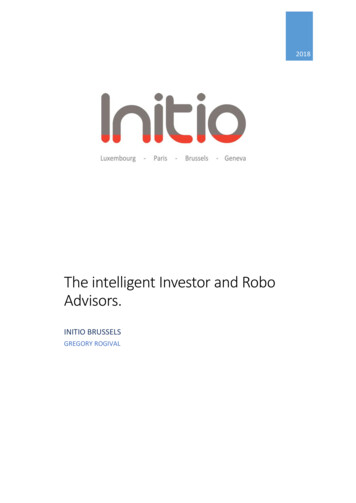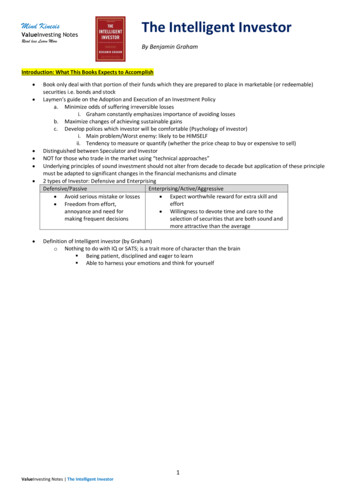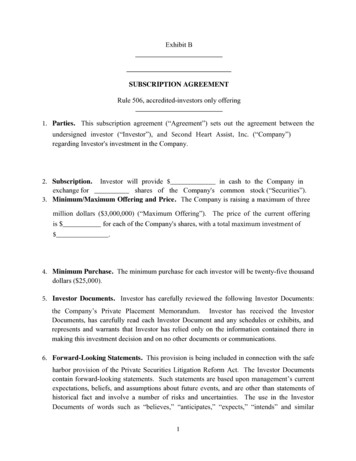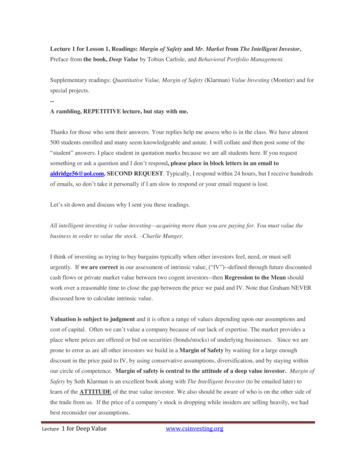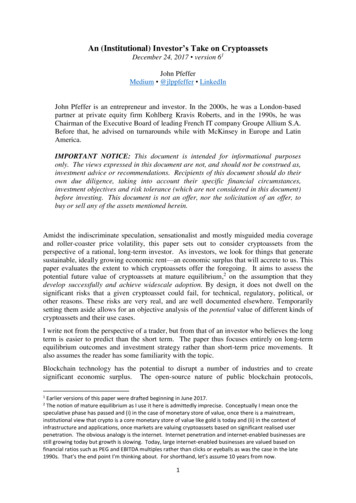
Transcription
An (Institutional) Investor’s Take on CryptoassetsDecember 24, 2017 version 61John PfefferMedium @jlppfeffer LinkedInJohn Pfeffer is an entrepreneur and investor. In the 2000s, he was a London-basedpartner at private equity firm Kohlberg Kravis Roberts, and in the 1990s, he wasChairman of the Executive Board of leading French IT company Groupe Allium S.A.Before that, he advised on turnarounds while with McKinsey in Europe and LatinAmerica.IMPORTANT NOTICE: This document is intended for informational purposesonly. The views expressed in this document are not, and should not be construed as,investment advice or recommendations. Recipients of this document should do theirown due diligence, taking into account their specific financial circumstances,investment objectives and risk tolerance (which are not considered in this document)before investing. This document is not an offer, nor the solicitation of an offer, tobuy or sell any of the assets mentioned herein.Amidst the indiscriminate speculation, sensationalist and mostly misguided media coverageand roller-coaster price volatility, this paper sets out to consider cryptoassets from theperspective of a rational, long-term investor. As investors, we look for things that generatesustainable, ideally growing economic rent—an economic surplus that will accrete to us. Thispaper evaluates the extent to which cryptoassets offer the foregoing. It aims to assess thepotential future value of cryptoassets at mature equilibrium,2 on the assumption that theydevelop successfully and achieve widescale adoption. By design, it does not dwell on thesignificant risks that a given cryptoasset could fail, for technical, regulatory, political, orother reasons. These risks are very real, and are well documented elsewhere. Temporarilysetting them aside allows for an objective analysis of the potential value of different kinds ofcryptoassets and their use cases.I write not from the perspective of a trader, but from that of an investor who believes the longterm is easier to predict than the short term. The paper thus focuses entirely on long-termequilibrium outcomes and investment strategy rather than short-term price movements. Italso assumes the reader has some familiarity with the topic.Blockchain technology has the potential to disrupt a number of industries and to createsignificant economic surplus. The open-source nature of public blockchain protocols,1Earlier versions of this paper were drafted beginning in June 2017.The notion of mature equilibrium as I use it here is admittedly imprecise. Conceptually I mean once thespeculative phase has passed and (i) in the case of monetary store of value, once there is a mainstream,institutional view that crypto is a core monetary store of value like gold is today and (ii) in the context ofinfrastructure and applications, once markets are valuing cryptoassets based on significant realised userpenetration. The obvious analogy is the internet. Internet penetration and internet-enabled businesses arestill growing today but growth is slowing. Today, large internet-enabled businesses are valued based onfinancial ratios such as PEG and EBITDA multiples rather than clicks or eyeballs as was the case in the late1990s. That’s the end point I’m thinking about. For shorthand, let’s assume 10 years from now.21
combined with intrinsic mechanisms to break down monopoly effects, mean that the vastmajority of this economic surplus will accrue to users. While tens or perhaps hundreds ofbillions of dollars of value will also likely accrue to the cryptoassets underlying theseprotocols and therefore to investors in them, this potential value will be fragmented acrossmany different protocols and is generally insufficient in relation to current valuations to offera long-term investor attractive returns relative to the inherent risks. The one key exception isthe potential for a cryptoasset to emerge as a dominant, non-sovereign monetary store ofvalue, which could be worth many trillions of dollars. While also risky, this potential valueand the probability that it might develop for the current leading candidate for this use case(Bitcoin) would appear to be sufficiently high to make it rational for many investors toallocate a small portion of their assets to Bitcoin with a long-term investment horizon.We can break cryptographic token use cases into three broad categories:1. Network backbone / Virtual Machine (e.g., Ethereum)2. Distributed applications (Dapps)3. Money, and in particular:a. Paymentsb. Monetary store of value.I will start by looking at the first two use cases from a general perspective and then divedeeper in analysing the largest current example of the first one, Ethereum. I’ll then turn to adiscussion of the different functions of money, the potential for cryptoassets to perform themand the implications for the value of such cryptoassets, including Bitcoin.The economics and valuation of utility protocolsUse cases 1 and 2 can be grouped into what I call utility protocols. I will start with somegeneral observations on utility protocols and the implications for their network valuation atequilibrium and then specifically consider the network value of Ethereum at matureequilibrium.General observationsA blockchain protocol is a database maintained by a decentralised consensus mechanismoperated by its nodes. Utility protocol tokens serve to provision scarce network resources:the processing power, memory, and bandwidth necessary for maintaining the blockchain inquestion. These resources have a real-world cost in terms of energy and the equipmentemployed, and these costs are borne by the miners who maintain the blockchain by providingcomputational services. The miners may be remunerated for their service with blockrewards, paid in protocol tokens, and/or transaction fees, paid in protocol tokens or someother means of exchange. While protocol developers may claim that tokens are the basis forother kinds of exchange among users and not just a means of allocating and paying forcomputing resources, it is my argument that, at mature equilibrium, tokens will do no morethan allocate computing resource, with the exception of the special case of a cryptoasset thatserves as a monetary store of value.A given protocol is analogous to a simplified economy. The GDP of such an economy wouldbe the aggregate cost of the computing resources necessary to maintain the blockchain, basedon the quantity of processing power, memory and bandwidth consumed, multiplied by theunit cost of each. The token is typically the currency used to pay for those resources. Thetotal network value is analogous to the money supply M (i.e., all tokens in issuance), whereM PQ/V; PQ (Price x Quantity) is the total cost of the computing resources consumed, V is2
a measure of how frequently a token is used and reused in the system (its velocity, V). Thevalue of a single token is therefore M/T, where T is the total number of tokens.If a given utility protocol does not have a built-in mechanism, such as Ethereum’sGASPRICE, to ensure that the cost of using the network does not arbitrarily and sustainablydiverge from the underlying cost of the computational resources it consumes, one of threethings happens: (a) the token’s price trades to a level such that there is no premium cost tousing the network (i.e., there is no economic rent); (b) the chain forks into a functionallyidentical but less rent-seeking chains until any premium usage cost and economic rent on thenetwork declines to a level at which it is no longer worthwhile to arbitrage; (c) the protocol’sadoption is temporarily limited to the highest-value use cases until (a) or (b) occurs. In allcases, the equilibrium result must be at or near marginal revenue marginal cost for themining industry maintaining the blockchain in question, so that the token’s value cannotmaterially decouple from the underlying computing resource cost.PQ, the cost of computing resources required to maintain a blockchain, is not only lowrelative to the current network values being attributed to cryptoassets; it is also inflated by theprevalence of proof-of-work consensus mechanisms, which mean that the vast majority ofcomputing resource consumed is make-work. To the extent that new scaling technologiessuch as proof-of-stake, sharding, Segregated Witness, Lightning, Raiden and Plasma becomeprevalent, the amount of computing resource consumed may become quite small. Note alsothat in the context of cryptoassets, V could go very high at equilibrium. Even if a significantportion of a given cryptoasset has a low velocity because it is being hodl’d by speculators orbecause it is staked by miners under a proof-of-stake consensus mechanism, the circulatingportion of the tokens can circulate at the speed of computer processing and bandwidth—i.e.,fast and accelerating. The implication is that average velocities can and are likely to be high,regardless of how many tokens are actually actively circulating for utility purposes to allocatenetwork resources.3 The combined effect of low and falling PQ and potentially very high Vis that the utility value of utility cryptoassets at equilibrium should in fact be relatively low.Clearly, scaling solutions such as proof-of-stake, etc. are bullish for adoption/users butbearish for token value/investors. Even without those technology shifts, the cost of usingdecentralised protocols is deflationary, since the cost of processing power, storage andbandwidth are deflationary. This is also bullish for adoption and users and bearish for tokenvalue and investors.4Whatever scaling solutions are developed, the inherent redundancy of the consensusmechanism means that there may be fewer use cases than many decentralised revolutionariesthink in which a decentralised solution displaces a centralised solution. Use cases will belimited to dematerialised networks where the value of decentralisation, censorship-resistanceand trustlessness is high enough to justify the inherent inefficiency and redundancy of theconsensus mechanism. Is it worth the cost for payments? Yes for some, but not for all.Consider Twitter -- what is the added value to the user of a massively redundant, trustless,3Chris Burniske’s recent blog post “Cryptoasset Valuations” ns-ac83479ffca7) estimates an average V of 7, after adjusting for hodlers, stakers, etc. This assumptionmay be optimistic (meaning, it is probably a low value of V to assume at equilibrium and therefore anoptimistic number to be using to estimate the potential equilibrium value of a given cryptoasset), but hisframework is useful for thinking about the different drivers of V for a given cryptoasset.4I have yet to come across any examples of a protocol where I have been persuaded that when all is said anddone the underlying scarce resource being provisioned is something other than computing resources, or atleast where that is what it will boil down to at competitive equilibrium after competition in mining, forks, etc.Please alert me to any counter examples you have seen or can think of.3
decentralised Twitter? Is that added value enough to offset its inefficiency compared to theincumbent centralised Twitter? Would Token Twitter offer compellingly higher utilitycompared to centralised Twitter, including enough surplus utility to offset the cost ofoperating the consensus mechanism? I’m not so sure.People often make the mistake of conflating the monopoly network effects of, say, Facebookto blockchain protocols. This notion is fallacious on several levels:5 Blockchain protocols can be forked to a functionally identical blockchain with thesame history and users up to that moment if a parent chain persists in being arbitrarilyexpensive to use (i.e., rent-seeking). Like TCP/IP but unlike Facebook, blockchainprotocols are open-source software that anyone can copy or fork freely. A protocolfork is analogous to a team of Facebook developers who decide one Tuesday morningthat Zuck is not paying them enough; they could simply flip a switch and use theservers and software that run Facebook to run a new Facebook that is functionallyidentical, with all the same users and data up to that point. That can, does, and willhappen all the time in protocol-land, but would be theft in the context of privatecompanies that own their code, data, intellectual property, etc. Those property rightsare why Zuck is rich, and their absence in the protocol economy has profoundimplications. The ability to fork protocols maximises utility for users but suppresseseconomic rent for token holders. When people talk about the potential value of cryptoassets, they often refer toMetcalfe’s Law. Metcalfe’s Law asserts that network value ϴ ּ n(n-1), where ϴ is aconstant that captures the differences in the economics built into the business modelof each network and where n is the number of nodes in the network. It’s not enoughto focus on n(n-1). You must also consider what ϴ is. Wikipedia has a lot ofcontributors and users but not a lot of monetary value because it doesn’t charge usersor have advertisers or attract any other sources of revenue apart from donations.Facebook’s ϴ is higher than Twitter’s because its advertising business model isstronger. TCP/IP lacks financial value not only because no one owns it but alsobecause it doesn’t have a revenue model. The problem for utility protocols is that theϴ in question is driven by the cost of the computing resources to maintain thenetwork, which is relatively low and deflationary and which must remain low for theiradoption to be successful vs. non-distributed technologies. When thinking about whether a protocol’s token can capture and sustain economicrent, what is relevant is whether the mining industry maintaining the protocol’sblockchain is competitive, not the stickiness of users. The mining industry supportingany decentralised protocol must be a competitive market; otherwise the protocol isn’tdecentralised. It is the economic competition amongst miners that will ultimatelydrive the cost of using the protocol and therefore the value of the token. Nomechanisms for monopoly rents there. Not only must protocols compete against their own potential forks; competitionamongst protocols is also fierce. Witness, for example, recent press reports that Kikis considering migrating its token network from the Ethereum backbone to anotherblockchain because the Ethereum network is becoming too expensive to co-tokens-to-a-new-blockchain/4
The network value of a tokenised version of a dematerialised network business (asocial network, Uber, AirBnB, a betting exchange, etc.) will by construction be asmall fraction of the enterprise value of its centralised, joint-stock-companyequivalent. Holding the number of users constant, you basically take the fully-loadedIT budget (including energy and a capital charge) of those companies (representingPQ) and divide by some (likely high) velocity V. The disruption of traditionalnetworked businesses by decentralised protocol challengers will represent anenormous transfer of utility to users and an enormous destruction of market value.Great for users, the economy and society; bad for investors.The next topic to address is the impact of a move to proof-of-stake mining and of stakingmodels in general on the network values of Ethereum and other protocols. The idea is thatminers are compensated for maintaining the network either in a native cryptoasset or anothercryptoasset (such as ETH or BTC), in proportion to the amount of the native networkcryptoasset that they stake (i.e., effectively put into escrow and at risk of loss if they attemptto validate false transactions and the like). The promoters of this idea hope that it willreduce the actual computing costs of maintaining the network, by eliminating the costlyproof-of-work mechanism, while at the same time creating an alchemic virtuous cyclewherein miners buy and lock up significant amounts of the native cryptoasset as aninvestment conveying them a right to a mining revenue stream, thereby reducing the velocityof the native cryptoasset and causing its value to rise to a level representing some multiple oftheir mining profits, much as taxi medallions or shares in a company are valued based on thenet present value of future cash flows.Let’s think through how this plays out.First, before staking is introduced into the equation, we’ve established that forks andcompetition in mining and among protocols lead us to an equilibrium outcome where PQequals the aggregate cost of the computational resources (capital charge on or usage cost ofprocessing and storage hardware, cost of bandwidth and energy) of maintaining the network.Second, recall that the impetus for moving from proof-of-work to proof-of-stake is to reducethe amount of computational resource and energy required to maintain the network by acouple orders of magnitude. That’s good for scalability and potential adoption, but alsomeans a commensurate reduction in the PQ of the network.Third, let’s layer on the idea that in order to participate in mining and the associatedrevenues, on top of paying for processing power, storage, bandwidth and energy, you mustnow bear an additional cost in the form of a capital charge from acquiring and immobilisingan amount of the native cryptoasset. This capital charge on immobilised cryptoasset is addedto PQ, making the protocol in question more expensive to use than an equivalent utilityprotocol that doesn’t require staking (or where staking is less expensive because the nativecryptoasset is cheaper).This system operates a bit like a taxi medallion system: an authority issues a finite number oflicenses, and you must buy one from another medallion holder if you want to operate a taxi.The value of the license captures the discounted value of any economic profits that areexpected to accrue from operation. Whoever owned the license first is the primarybeneficiary of this monopoly, and he receives that value when he sells the license tosomeone. The buyer of the license does not enjoy any economic rent because he paid thediscounted present value of it to the previous license holder, and so on as the license changeshands. Passengers pay higher fares because the taxi driver’s capital cost of buying the licensemust be compensated for, all for the benefit of the first owner of the license.5
Imagine there are several different taxi companies operating that have acquired a number oflicenses. Now imagine that a new entrant decides it would like to take market share. In theworld of a taxi medallion monopoly created by an issuing public authority, they would haveno option other than to buy medallions from other medallion owners. But here is whereprotocol-land is different from real-world taxi medallion schemes. Protocols are open sourcesoftware and can be freely forked.In protocol-land, all the upstart taxi company needs to do is to fork the protocol, effectivelyissuing an identical number of new taxi medallions and reallocating medallions owned byexisting large taxi companies to itself and perhaps a few other friends. Because the upstarttaxi company didn’t have to pay for its taxi medallions, it and the other recipients of the newmedallions can charge its passengers lower fares. Passengers thus flock to the upstartcompany, and the monopoly value embedded in the original taxi medallions vanishes.Everyone in the system except for the large taxi company wins. If necessary, this process canbe repeated indefinitely. The result is that the medallions have low values (as would theanalogous native cryptoasset).6Another mechanism for utility protocols is mine and burn. In this system, new coins areminted and allocated to miners based on the network services they provide, and users mustbuy these coins and burn them to pay for transaction processing. This is a perfectly finemechanism, but it simply ensures that the network value equals PQ/V, where PQ is the actualfiat cost of maintaining the network and V is the average time from minting to burning. Thatgets you to the same low equilibrium network value more simply and quickly.Other general observations: Analysts often use a working capital analogy in order to assess how much of a givencryptoasset a user will stock to facilitate actual use of a given blockchain’s utilityfunction. Fair enough, but digging further into that line of thinking, the way optimalinventories of a good are set is based on the relationship of the volume and volatilityof demand, optimal order sizes, communication and delivery latency and productiontimes. Since cryptoassets are generally highly divisible and may circulate very fast(as fast as processor speed and bandwidth allow), it would seem to me that a userwould, by the same maths as those used to determine optimal inventory quantities,conclude that he needs to hold very little inventory of a given cryptoasset. Frictionmoving among cryptoassets is already low and will quickly disappear entirely withtechnologies like atomic swaps. Consequently, one would expect velocity to be veryhigh at equilibrium. It would make no more sense for users to hoard utilitycryptoassets beyond the minimum they need to carry out their desired operations thanit would be for individuals to hoard petrol or for companies to hoard giant warehousesfull of whatever goods they sell. Companies need inventories of goods to run abusiness and those inventories have a value on their balance sheet, but they try tominimise such holdings, as they are unproductive assets that are costly to finance andcarry. They certainly don’t try to accumulate more inventory than necessary as a wayto store their retained earnings. Similarly, individuals have petrol in the tanks of theircars, but they don’t stockpile petrol in their basements as a form of savings.76The competitive forces to eliminate economic rent would function in largely the same way whether thestaking system involves payment for services in cryptoassets that are native or external to the protocol athand.7See also Vitalik Buterin’s recent blog post: “On Medium of Exchange Token /moe.html)6
For every successful utility protocol (certainly for every successful Dapp), there willbe n failed versions. In fact, one of the advantages of the protocol economy is that itfacilitates open and inexpensive experimentation, which will mean that there will bemany more attempts and many more failures, and that each success will beindividually smaller in its value and reach. The open-source, forkable nature of thiskind of software will likely drive toward a fragmentation of use cases and protocolfunctionality; businesses built on top of the protocols will be protocol agnostic andcapable of using and combining modularly a changing array of protocols to deliverwhatever service or value chain they are trying to deliver. These dynamics are greatfor users and generate lots of positive economic and social externalities, but they arebad dynamics for investors.8 The problem of making money by investing in utilityprotocols is aggravated by: (a) the fact that this is a fragmented space with very highfailure rates, so selecting winners a priori will be very difficult; and (b) the fact thatmost of the long-term winning protocols probably haven’t even been launched yet(witness the fact that the most valuable internet businesses were founded after 2001). Developer incentives over time are a fundamental issue in crypto. For most protocols,such incentives are heavily front-ended around launch and insufficiently provided forover time. The more ambitious and long-term a protocol’s development roadmap is,the more problematic this failure of incentives becomes. The incentives to improvean existing protocol by forking it may be strong if some tokens are reallocated at thefork to the developers making the improvements. For example, where tokens havebeen retained by a foundation linked to the original protocol developers, an aggressivegroup of forking developers could reallocate the foundation’s tokens to their own newentity in their fork, leaving all other users in the same position and letting the marketdecide which fork to support. The incentives for a developer to create a new,competing protocol are also strong, but network effects do make it harder to displacean existing protocol than to improve or fork it. Miners and perhaps large users have astrong economic incentive to invest in development of the protocol they are miningeither through changes to the protocol or by forking it. The foregoing suggests thatwe’re likely to see (a) more success with protocols focused on simple use-cases thatrequire less ambitious future development; (b) future protocols launched with betterlong-term developer incentive schemes (easier said than done)9; (c) aggressive forksthat transfer value from incumbent to challenger developers10; and (d) largeminers/users or groups of miners/users acting together employing or payingdevelopers to improve legacy protocols either directly or via forks.The implication of this section is not that utility protocols won’t have any network value.PQ/V does represent positive value. The implication is that network value of a utility8See also Teemu Paivenen’s blog post “Thin Protocols” 72258379f).9Tezos proposes an interesting potential solution to the developer incentive problem. Tezos combines a PoSconsensus mechanism with a system whereby token-holders can vote on improvements to the protocolproposed by developers and reward the developers for their contribution. We’ll see if it works, but theproblem for Tezos remains that the mature equilibrium value of the Tezos token will be TTezos PQ/VM wherePQ is the cost of the computing resource maintaining the Tezos blockchain, i.e., TTezos probably won’t have ahigh value when the dust settles.10See also Fred Ersham’s blogpost “Accelerating Evolution through g-evolution-through-forking-6b0bba85a2ba)7
protocol will converge on or near an equilibrium, where it is a fraction (denominator V) ofthe actual cost of the computing resources consumed to maintain the networks.For a fork to succeed, there needs to be enough value available to arbitrage to incentiviseusers, some miners and a sufficiently credible developer group to support the fork. It shouldtherefore be acknowledged that, to the extent the equilibrium outcome is arrived by way ofone or more forks, there could be a sustainable level of network value economic rentpremium above computing cost that is too small to provide adequate incentives for a fork tosucceed. I would not, however, consider it to be a very compelling investment thesis whenthe best I can hope for is to keep an amount of value corresponding to an economic rent that’stoo small for anyone to bother arbitraging it away from me despite relatively low barriers todoing so. While a protocol’s core development team may be bound by various soft ties, inprotocol-land (unlike in a traditional software business), the work product is all open-source;intellectual property isn’t generally owned or protected; and developers have little or nothingin the way of contractual ties or limitations (e.g., no non-compete, no non-disclosure, no nonsolicit). That means developers can defect or take the work of others. At a minimum, thesefactors place a low ceiling on how much economic rent can be created and sustained.11As illustrated in the ETH valuation example to follow, it is likely that the combined networkvalues of all utility protocol cryptoassets together will total between tens of billions andhundreds of billions of dollars. That is significant value, but not when compared to thecurrent 250 billion combined network value of protocols other than Bitcoin. Investing inutility protocol cryptoassets could make sense if their current network values were one or twoorders of magnitude lower than they currently are, but at current valuations, the risk/return toinvestors is not attractive.The Network Value of ETHETH, the Ethereum token, is an interesting case to explore because of its significant currentnetwork value and Ethereum’s potential as the ultimate utility protocol. Ethereum couldserve as the backbone for processing smart contract operations for (hopefully) untoldnumbers of decentralised applications, DAOs, etc., and perhaps one day maybe evensomething like the fabled Ethereum Virtual Machine (EVM).Ethereum’s developers understood that for Ethereum to fulfil its potential, the cost of using itas a smart-contract-executing utility must be as low as possible and must not depart atequilibrium from the actual cost of the computational resources consumed. To ensure thiswill be the case, they built the GAS mechanism into Ethereum to decouple the use of thenetwork (and the cost thereof) from the value of the ETH token.Each possible type of computing operation has a pre-defined GASCOST, measured in unitsof GAS. GAS may then be paid for using ETH (or another token or currency) based on theGASPRICE ‘exchange rate’, which is freely set among users and miners.1211An interesting business idea that someone could logically pursue at some point would be to raise capital tofund a crack team of mercenary blockchain developers and systematically target technically-mature ormaturing protocols where there is still a significant economic rent premium and arbitrage that value via hostileforks of those protocols in a way that reduces cost and/or improves functionality to users and reassignsnetwork tokens held by the incumbent developer team and backers to the insurgent team and backers.12Note that because GASPRICE is fully-flexible, GASCOST might only need to be updated in the system fromtime to time if and to the extent the relative cos
John Pfeffer is an entrepreneur and investor. In the 2000s, he was a London-based partner at private equity firm Kohlberg Kravis Roberts, and in the 1990s, he was . and roller-coaster price volatility, this paper sets out to consider cryptoassets from the perspective of a rational, long-term investor. As investors, we look for things that .
